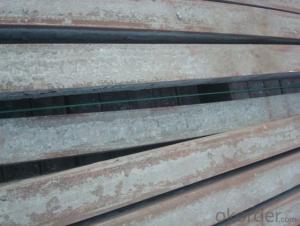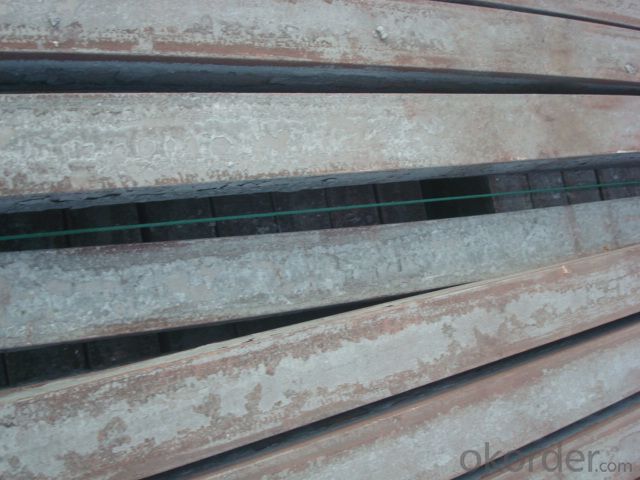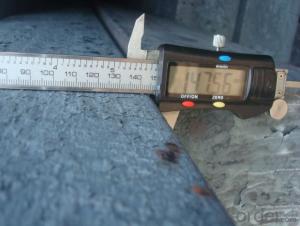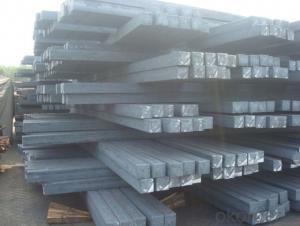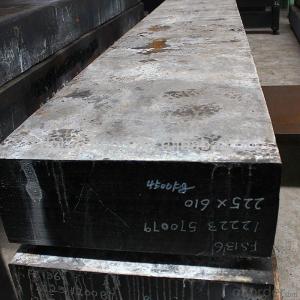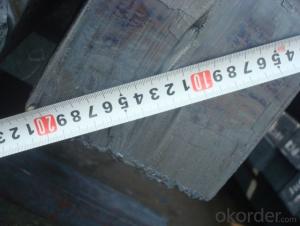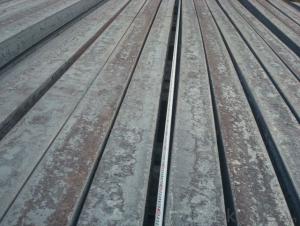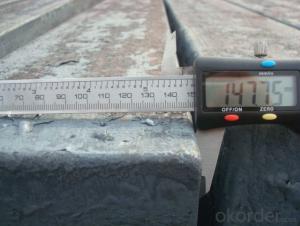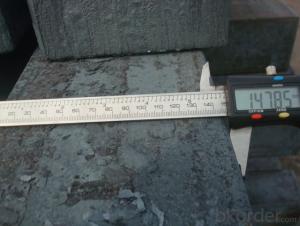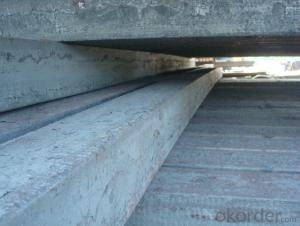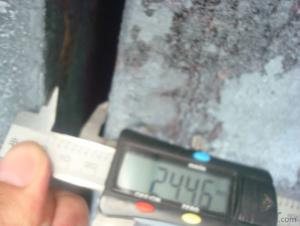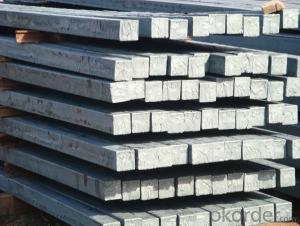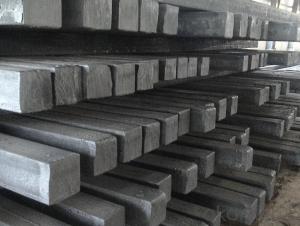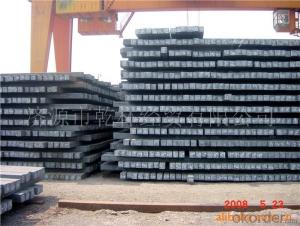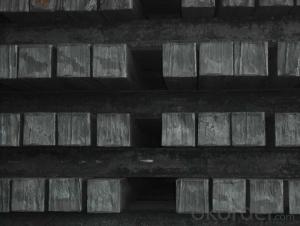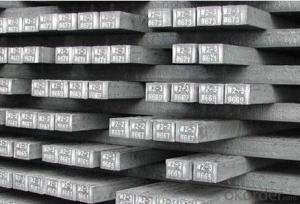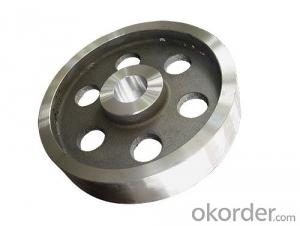Steel Billets or Blooms Manufactured by Continue Casting
- Loading Port:
- Tianjin
- Payment Terms:
- TT OR LC
- Min Order Qty:
- 1000 m.t.
- Supply Capability:
- 10000 m.t./month
OKorder Service Pledge
OKorder Financial Service
You Might Also Like
Steel Billets or Blooms Manufactured by Continue Casting
1.Structure of Steel Billets or Blooms Manufactured by Continue Casting
Steel Billets or Blooms Manufactured by Continue Casting is the raw material of all kinds of steel mill. Billet section of square, round, flat, rectangular and abnormity, etc Several, mainly related to shape of rolled products. Simple rolled section steel, choose cross section of square billet or rectangular billet. rolling The sector products such as flat steel, Angle steel, select the rectangular billet or slab. Had better profiled billet when production beams, channels, and in rolling process Lines and improve the yield. The raw material of round billet is the production of seamless tube.
2.Main Features of Steel Billets or Blooms Manufactured by Continue Casting
Steel Billets Manufactured by Continue Casting section size should meet the requirements of rolling deformation and finished product quality, but also roll strength and biting condition of restrictions. General steel Billet section height H. And the roll diameter D The ratio of the ( namely H/D) Should be less than or equal to zero 0.5 . Length of steel billet by finishing temperature, Rolling time and the length of the product Or times ruler. When heated too long accident prone to bump the furnace wall of steel, too short, furnace bottom utilization rate is not high, influence the heating furnace production. For the production Choose a variety of steel and steel billet, should consider the affinities of billet, as far as possible in order to improve the productivity of the roughing mill, simplify the stock management of workshop.
There are three shapes of the steel billets: square billet, slab, rectangular billet The Chinese billet, rectangular billet is mainly suitable for rolling hot rolled strip, building reinforced bar, Ordinary wire, high speed wire rod and various small profile. Of the slab are mainly used for rolling plate and hot coil sheet.
3. Steel Billets or Blooms Manufactured by Continue Casting Images
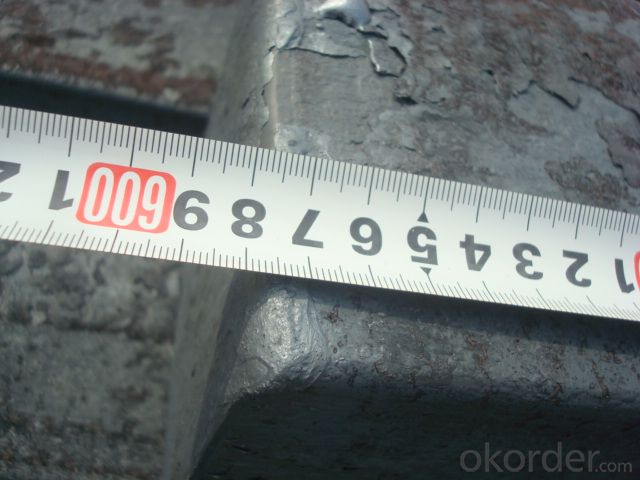
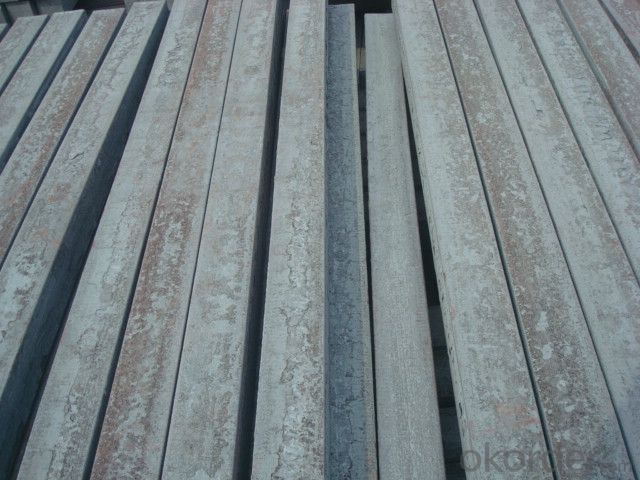
4. Steel Billets or Blooms Manufactured by Continue Casting Specification
Steel Billets Manufactured by Continue Casting rolled steel, after processing can be used for mechanical parts, forging parts, processing all kinds of steel, steel Q345B channel steel, wire rod is the role of the billet. Steel billet is used in the production of semi-finished products, generally cannot be used directly for the society. Steel billets and steel are strictly divided into standard, cannot decide to whether the business enterprise of the final product, and according to unified standards to perform the whole society. Typically, billet and the steel is relatively easy to distinguish, but for some steel billet, and have the same specification and same steel purposes (such as rolling tube billet), whether can be used for other industries, whether through steel processing process, whether through a finished product rolling mill processing to distinguish
Material standard The editor Range of thickness: 150-240 - mm + / - 5 mm width range: 880-1530 - mm + / - 20 mm Length: 3700-10000 - mm + / - 500 - mm Cross-sectional size: 64 * 64; 82 * 82; 98 * 98; 124 * 124; 120 * 150; 152 * 164; 152 * 170 mm Length: 9000 mm Section of tolerance: billet: 1.0 + / - 2.0-1.0 + / - 1.0 mm slab: width: + / - 2.0 mm thickness: + / - 3.0 mm The length tolerance: + / - 200 mm Section diagonal tolerance: 3.5-8.0 MM Billet section size protrusions requirements: < 1242 mm, do not allow; > = 1242 mm, < = 2 mm 1242 mm, < = 3 mm Beheading (shear) extension deformation: < 1242 mm billet: no control; The slab: < = 15 mm Surface tilt: no more than billet section 0.1 Bending: every 1 m length is not more than 10 mm The distortion: length < = 5 m, < = 11. ; The length of the < = 7.5 M, < = 5. Material % 3 sp/PS chemical composition: C Mn Si S P
5.FAQ of Steel Billets or Blooms Manufactured by Continue Casting
We have organized several common questions for our clients,may help you sincerely:
①How about your company?
A world class manufacturer & supplier of castings forging in carbon steel and alloy steel,is one of the large-scale professional investment casting production bases in China,consisting of both casting foundry forging and machining factory. Annually more than 8000 tons Precision casting and forging parts are exported to markets in Europe,America and Japan. OEM casting and forging service available according to customer’s requirements.
②How to guarantee the quality of the products?
We have established the international advanced quality management system,every link from raw material to final product we have strict quality test;We resolutely put an end to unqualified products flowing into the market. At the same time, we will provide necessary follow-up service assurance.
The causes of surface transverse crack and prevent method have? Transverse cracks in the slab vibration mark the surface of the inner arc wave trough, is usually not hidden, crack depth can be up to 7 mm, width is 0.2 mm.Cracks in the existing body of the mesh area.The cause of general is disorder caused by the continuous casting process control.Such as: vibration mark too deep, Al, N content in steel, prompting particle (A1N) in the grain boundary precipitates, induced transverse crack;Billet straightening within the range of brittleness temperature 700 ~ 900 ℃;Secondary cooling is too strong, and so on. Continuous casting process and some measures to prevent the transverse crack in general are: mold using high frequency small amplitude;With smooth and weak cooling, secondary cooling and make the slab surface temperature greater than 900 ℃;Mould liquid level is stable, and USES the good lubrication performance, low viscosity of protecting slag.
③What is the advantage of the continue Casting steel billet comparing to the die casting steel billet?And how is the process?
Compared with die casting, continuous casting has the advantages of: 1. To simplify the Steel billet The production process 2. Improve the metal yield 3. Improve the quality of the billet 4. Reduces the steel worker's labor intensity 5. Save energy and reduce consumption
Steel billet is produced by the method of through three processes: It is through the steelmaking system of continuous casting equipment, directly by the molten steel pouring into billet; The second is the steelmaking system in the production of steel ingot casting billet through system of steel rolling rolling equipment or processing of steel semi-finished products; Three is the steelmaking system production of steel ingot by forging the semi-finished product processing equipment.
- Q: How are steel billets packaged for shipment?
- Steel billets are packaged in a manner that guarantees their protection and facilitates convenient handling for shipment. The packaging process involves multiple steps to ensure the safe transportation of the billets. First and foremost, the steel billets undergo inspection to ensure that they meet the required quality standards. Upon approval, they are cleaned and dried to eliminate any dirt or moisture that may cause corrosion during shipment. Following that, the billets are bundled together using steel strapping or wire to secure them in a compact form. This bundling not only prevents the billets from shifting or rolling during transportation but also makes it easier to handle and load them onto trucks or containers. Additionally, to provide further protection, the steel billets are often wrapped in a layer of plastic or paper. This extra layer acts as a barrier against moisture, dust, and other potential contaminants that could harm the billets during transit. Once the billets are bundled and wrapped, they are typically loaded onto pallets or placed in steel crates. This ensures stability during transportation and allows for ease of movement and stacking using forklifts or cranes. Lastly, the packaged steel billets are labeled with relevant information such as the product name, dimensions, weight, and destination. This labeling guarantees accurate identification and aids in the efficient handling and delivery of the billets. In summary, steel billets are packaged for shipment with a focus on protection, ease of handling, and efficient transportation. These packaging measures guarantee that the billets arrive at their destination in optimal condition, ready for further processing or utilization in various industries.
- Q: How are steel billets inspected for surface finish?
- To ensure quality and compliance with industry standards, various methods and techniques are employed to inspect the surface finish of steel billets. Visual inspection is a common approach, where trained inspectors carefully examine the billet's surface for any defects, such as scratches, pits, cracks, or irregularities. This examination is typically conducted under appropriate lighting conditions to enhance defect visibility. Another method employed is non-destructive testing (NDT), which encompasses techniques like magnetic particle inspection (MPI) and liquid penetrant inspection (LPI). MPI involves the application of a magnetic field to the billet, followed by the use of a magnetic particle suspension to reveal surface defects by adhering to them. On the other hand, LPI involves the application of a liquid penetrant solution to the billet's surface, which is subsequently removed and followed by the application of a developer to highlight any defects. Ultrasonic testing (UT) is also commonly utilized to inspect the surface finish of steel billets. UT employs high-frequency sound waves transmitted through the billet, with any reflected waves analyzed to detect surface or subsurface defects. This method provides detailed information about the surface condition and can even detect minute flaws. Additionally, surface profilometers can be employed to measure the roughness of the billet's surface. These devices utilize a stylus or laser to measure height variations on the surface, thereby providing data on roughness and texture. In summary, a combination of visual inspection, NDT techniques, and surface profilometry is employed to conduct thorough inspections of steel billets' surface finish. These inspections play a crucial role in ensuring that the billets meet the required surface finish standards and are suitable for further processing or manufacturing.
- Q: What is the role of steel billets in the manufacturing of industrial boilers?
- Steel billets play a crucial role in the manufacturing of industrial boilers as they serve as the raw material from which various boiler components are fabricated. These billets are heated and formed into specific shapes and sizes to create boiler tubes, plates, and other structural elements. The high strength and thermal conductivity of steel make it an ideal choice for withstanding the high temperatures and pressures involved in boiler operations. Ultimately, steel billets provide the foundation for the construction and functionality of industrial boilers, ensuring their durability and efficiency in various industrial applications.
- Q: What are the different methods of steel billet casting?
- There are several methods of steel billet casting, including continuous casting, ingot casting, and direct casting. Continuous casting is the most common method, where molten steel is poured into a water-cooled mold and solidifies into a continuous strand. Ingot casting involves pouring molten steel into individual molds to create solid metal ingots. Direct casting, also known as hot top casting, involves pouring molten steel directly into a single mold without using any intermediate steps. Each method has its own advantages and is used based on the specific requirements of the steel billet.
- Q: What are the different types of steel used for manufacturing billets?
- Manufacturing billets commonly employ various types of steel, each possessing unique properties and applications. Some frequently utilized steel types for this purpose encompass: 1. Mild Steel: Widely employed for billet manufacturing, mild steel exhibits low carbon content and is renowned for its strength and ductility. It suits general-purpose applications that do not necessitate high strength. 2. Carbon Steel: Containing higher carbon levels than mild steel, carbon steel offers enhanced hardness and strength. Hence, it is suitable for wear-resistant applications like tools and machinery components. 3. Alloy Steel: Alloy steel is produced by incorporating diverse alloying elements, including manganese, nickel, chromium, or molybdenum, into the base iron. Consequently, it exhibits augmented strength, durability, and corrosion resistance. The automotive, aerospace, and construction industries typically employ alloy steel billets. 4. Stainless Steel: Stainless steel is an alloy comprising at least 10.5% chromium, which endows it with remarkable resistance against corrosion and staining. Consequently, it is ideal for applications requiring high hygiene levels, such as food processing equipment and medical devices. 5. Tool Steel: Tool steel, a high-carbon steel, is specifically engineered for tool, die, and mold production. It is renowned for its hardness, wear resistance, and ability to retain shape at elevated temperatures. 6. High-Speed Steel: This type of tool steel is designed to endure high temperatures without compromising its hardness. It is frequently employed for cutting tools like drills and milling cutters. These examples merely represent a fraction of the steel types utilized for billet manufacturing. The selection of steel hinges upon specific requirements, such as strength, durability, corrosion resistance, and temperature resistance, dictated by the application at hand.
- Q: What are the different surface treatments for improved surface hardness in steel billets?
- To enhance the surface hardness of steel billets, there are various surface treatments available. These treatments aim to increase the wear resistance and durability of the steel, making it suitable for a range of industrial uses. One frequently used method is carburizing, which involves exposing the steel billet to a carbon-rich environment, like methane or propane. This process introduces carbon into the surface, creating a hard layer called a case that significantly boosts the billet's surface hardness. Another technique is nitriding, where the steel billet is exposed to a nitrogen-rich atmosphere at elevated temperatures. This causes nitrogen atoms to diffuse into the surface, forming a hard nitride layer. Nitriding not only enhances surface hardness but also improves resistance to wear and corrosion. Induction hardening is a third method that utilizes electromagnetic induction to rapidly heat the steel billet's surface. After reaching the desired temperature, the billet is quickly cooled, resulting in a hardened surface layer. This treatment is especially effective for localized hardening of specific areas. Furthermore, shot peening is a surface treatment that involves bombarding the steel billet's surface with small, high-velocity steel shots. This process induces compressive stresses in the surface layer, thereby increasing hardness and fatigue resistance. Each of these surface treatments comes with its own advantages and disadvantages. The choice of treatment method depends on the specific requirements and intended use of the steel billets. By selecting the appropriate surface treatment, manufacturers can ensure that the steel billets possess the necessary hardness and durability for their intended applications.
- Q: What is the role of steel billets in the manufacturing of automotive transmission systems?
- Steel billets play a crucial role in the manufacturing of automotive transmission systems as they are the starting material for forging various components such as gears, shafts, and other critical parts. The billets are heated and then shaped through the forging process to achieve the desired dimensions and strength required for these transmission components. The use of steel billets ensures the durability, reliability, and overall performance of automotive transmission systems in vehicles.
- Q: What are the different surface treatments for steel billets?
- Steel billets can undergo various surface treatments to enhance their performance and safeguard them against corrosion. Hot-dip galvanizing is a popular method, which involves immersing the billets in molten zinc to create a protective coating that acts as a barrier against moisture and corrosive elements. Electroplating offers another option, where a thin layer of metal like chromium or nickel is deposited onto the billet surface using an electric current. This not only provides corrosion resistance but also enhances the appearance of the billets. Painting or powder coating is a third approach, wherein a layer of paint or dry powder is applied to the billet surface. This forms a protective barrier, preventing moisture and corrosive substances from reaching the steel. Shot blasting or sandblasting can also be utilized for surface treatment. This technique involves propelling abrasive particles at high speeds onto the billet surface to eliminate impurities and scale, resulting in a clean and smooth finish. Lastly, chemical treatments like phosphating are available. Phosphating involves immersing the steel in a phosphoric acid solution, forming a protective phosphate coating that improves corrosion resistance and promotes paint adhesion. Ultimately, the choice of surface treatment for steel billets depends on the specific requirements of the application and the desired level of protection against corrosion and environmental factors.
- Q: How do steel billets contribute to the mining industry?
- Steel billets are an important component of the mining industry as they play a crucial role in the production of various mining equipment and infrastructure. These billets, which are semi-finished steel products, are used to manufacture a wide range of tools and machinery required for mining activities. One of the primary applications of steel billets in the mining industry is in the production of mining machinery and equipment. These billets are used to create the structural components of heavy machinery such as excavators, bulldozers, and drilling rigs. The strength and durability of steel make it an ideal material choice for these applications, as it can withstand the harsh conditions and heavy loads encountered in mining operations. Steel billets are also utilized in the construction of mining infrastructure. Mining operations require the construction of various structures such as conveyor systems, processing plants, and storage facilities. Steel billets are used to fabricate the structural elements of these buildings, providing the necessary strength and stability to support the mining operations. In addition, steel billets are essential for manufacturing mining tools and equipment. Tools such as drills, hammers, and picks are made from steel billets due to their strength and hardness. These tools are used in various mining processes, including exploration, extraction, and processing of minerals. Furthermore, steel billets contribute to the mining industry by enabling the transportation of extracted minerals. Steel billets are used to manufacture rail tracks and wagons, which are essential for the transportation of minerals from the mining site to processing facilities or ports for export. Overall, steel billets are a vital component of the mining industry, supporting the production of machinery, infrastructure, tools, and transportation systems. Their strength, durability, and versatility make them an indispensable material in the mining sector, helping to drive its growth and efficiency.
- Q: What are the different types of heat treatment processes used for steel billets?
- There are several different types of heat treatment processes used for steel billets. Some commonly used methods include annealing, normalizing, quenching and tempering, and case hardening. Each process has its own purpose and is used to achieve specific properties in the steel billets.
Send your message to us
Steel Billets or Blooms Manufactured by Continue Casting
- Loading Port:
- Tianjin
- Payment Terms:
- TT OR LC
- Min Order Qty:
- 1000 m.t.
- Supply Capability:
- 10000 m.t./month
OKorder Service Pledge
OKorder Financial Service
Similar products
Hot products
Hot Searches
Related keywords
